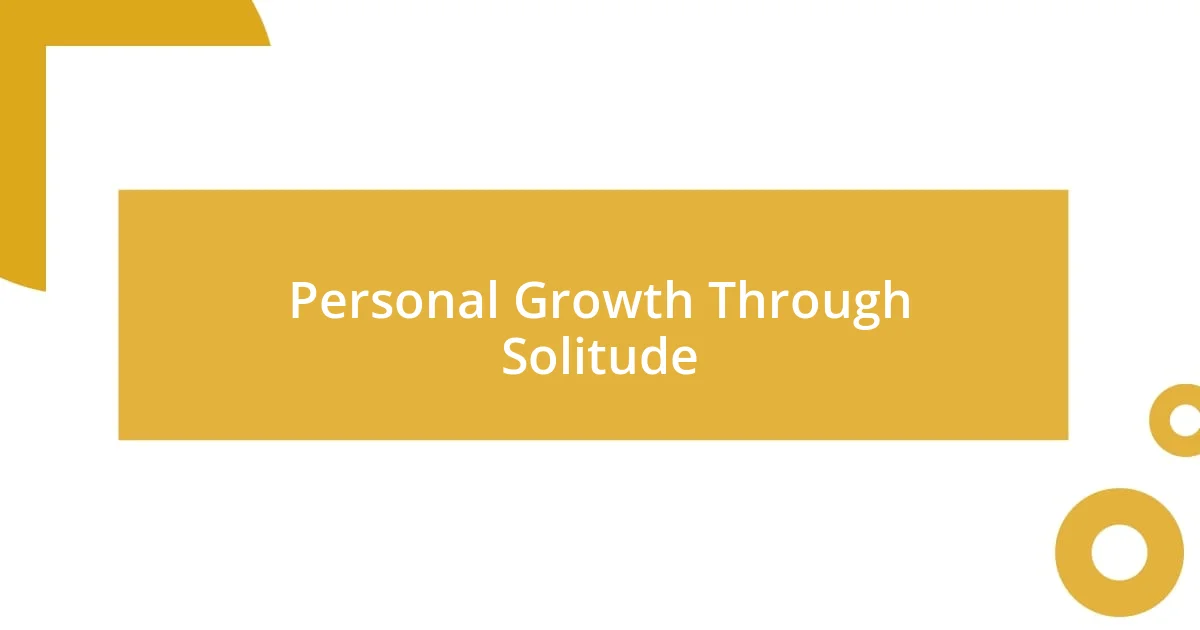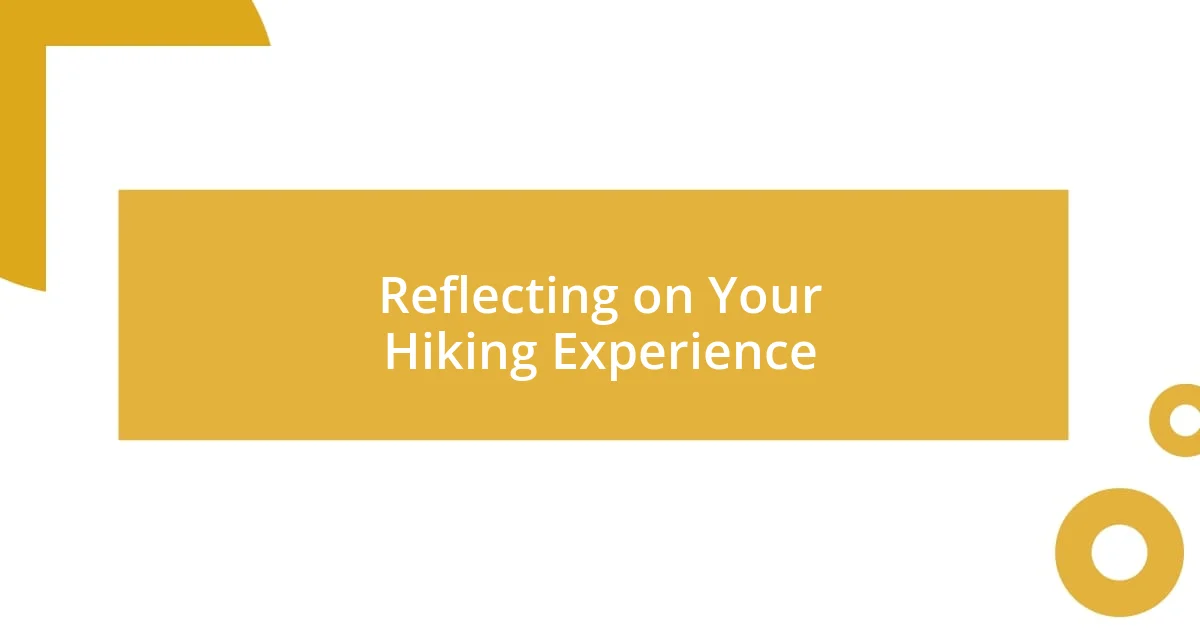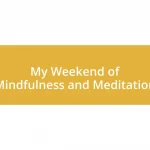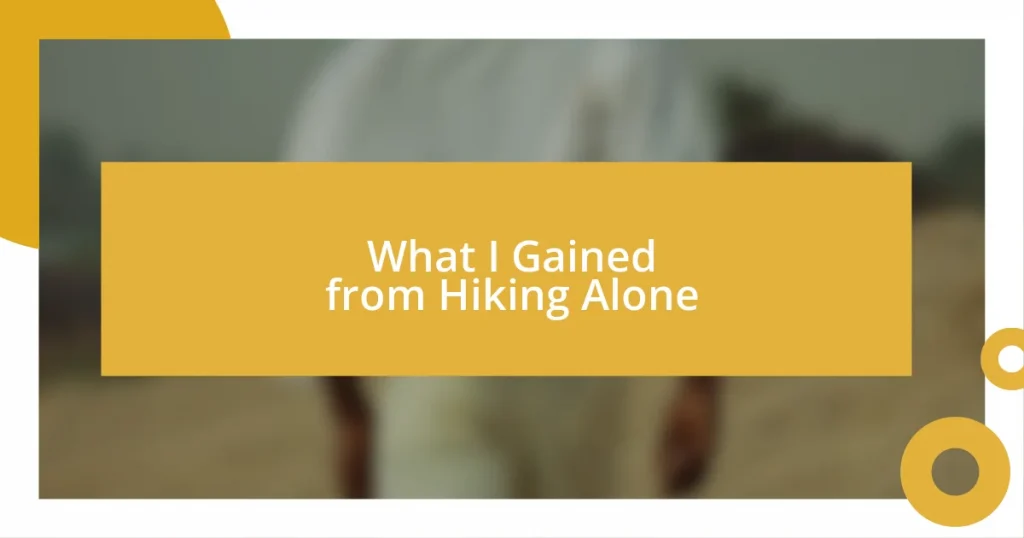Key takeaways:
- Hiking alone fosters self-discovery, empowerment, and a deep connection with nature, offering clarity and confidence through solitude.
- Preparation is crucial for solo hiking, including selecting familiar trails, packing essential gear, and informing someone of your plans for safety.
- Reflecting on solo hikes enhances personal growth, inspires creativity, and allows for the appreciation of both nature and self through overcoming challenges.

Benefits of Hiking Alone
One of the most profound benefits of hiking alone is the opportunity for self-discovery. I remember a solo hike I took one afternoon. As I walked through the quiet trails, my mind began to wander, revealing thoughts and feelings I hadn’t addressed in a while. Have you ever felt completely alone yet strangely connected to your inner self when surrounded by nature? It’s in this solitude that I often find clarity.
There’s also a unique sense of freedom that comes with solitary hiking. Imagine setting out on a path with no one else to consider. You can choose your own pace and direction, unhindered by another’s preferences. For me, that meant taking a moment to pause and breathe in the crisp air at a hidden viewpoint that I might have missed if I were with a group. Doesn’t that sound liberating?
Lastly, hiking alone can be incredibly empowering. During one trip, I faced a steep climb that seemed daunting at first. While I questioned my ability to reach the summit alone, I eventually pushed forward, and when I finally made it, the feeling of accomplishment was unmatched. Have you ever experienced that rush of confidence when you tackle a challenge solo? That’s exactly what keeps me returning to the trails alone, time and time again.

Preparing for Solo Hiking
Preparing for a solo hike requires careful consideration and planning. I always start by selecting the right trail. For example, I remember my first solo hike; I chose a familiar yet challenging route. It was comforting to know the path, and it allowed me to focus on enjoying the experience rather than stressing about getting lost. Knowing the terrain can significantly enhance your confidence while hiking alone.
Another aspect that I find essential is packing the right gear. I once went on a hike with minimal supplies, thinking I’d be fine with just a water bottle and snacks. That day turned out to be much longer than I anticipated, and I ended up being quite uncomfortable. It was a lesson well learned! I now pack everything—proper footwear, a first aid kit, and layers for unexpected weather. They can make or break your solo adventure.
Lastly, I make sure to share my plans with someone before heading out. This simple act of communication provides an extra layer of safety. I recall a time when I texted a friend with my itinerary. During my trek, I felt more secure, knowing someone was aware of my whereabouts. It’s a small step that can provide real peace of mind on those solitary journeys.
| Aspect | Description |
|---|---|
| Trail Selection | Choose familiar trails to build confidence and enjoy the experience. |
| Packing Gear | Ensure all essentials are packed, avoiding discomfort and potential issues. |
| Sharing Plans | Inform a friend about your hiking plans for safety while solo. |

Choosing the Right Trail
Choosing the right trail is crucial for a rewarding solo hiking experience. I vividly recall a time when I impulsively chose a less-traveled path, enchanted by the idea of solitude. What I didn’t anticipate was the overgrown thorns and rocky terrain that awaited me. While the struggle ultimately added to my adventure, it also taught me the importance of researching trail conditions beforehand.
When selecting a trail, consider these factors:
- Experience Level: Pick a trail that aligns with your hiking abilities.
- Duration: Make sure the hike is manageable within your available time.
- Scenery: Choose trails that offer the views or nature types you want to experience.
- Popularity: Research how busy a trail is; a quieter path might bring the solitude you seek.
- Weather: Always check forecasts; some trails can become treacherous in certain conditions.
Reflecting on my solo hikes, I’ve learned that thorough preparation leads to profound enjoyment. Selecting a trail, in essence, is about finding that sweet spot where your capabilities meet nature’s offerings. This decision can shape the very fabric of your adventure.

Essential Gear for Solo Hikers
When it comes to essential gear for solo hiking, having the right items can truly elevate your experience. One item I never leave behind is a reliable daypack. On a chilly morning hike, I once underestimated the temperature and didn’t bring an extra layer. Midway through my trek, I regretted that decision. Now, I ensure my pack has a warm, lightweight jacket tucked away for those unpredictable moments. Have you ever found yourself shivering because you didn’t pack wisely?
Another must-have item I swear by is a portable charger. I recall a day when my phone’s battery was nearly dead, and I wanted to capture the stunning sunset at my favorite viewpoint. Fortunately, I had packed a small charger, which not only allowed me to get those cherished photos but also provided peace of mind in case of an emergency. Carrying additional power means you’re not just documenting your journey but staying connected and safe. Isn’t it reassuring to know you can get help if needed?
Lastly, don’t overlook the importance of navigation tools. Whether it’s a GPS device or a reliable map, I’ve learned that being lost is a stark reality when hiking alone. During one of my solo outings, I ventured off the beaten path, captivated by a hidden waterfall. While the detour was beautiful, I quickly realized my phone’s GPS wasn’t functioning without service. After an unexpected detour, I promised myself never to hike without a physical map again. Having a clear sense of direction helps me explore with confidence, don’t you think?

Personal Growth Through Solitude
Embracing solitude on the trails has profoundly shaped my personal growth. I once found myself on a secluded ridge, surrounded by nothing but the whisper of the wind and the distant calls of birds. That moment of stillness allowed me to confront my thoughts without distraction, leading to unexpected clarity about my life’s direction—something I hadn’t anticipated when embarking on that hike.
There’s something transformative about spending time alone in nature. I remember a hike where, after a couple of hours alone with my thoughts, I felt a rush of emotions—fear, joy, and even sadness. It was as if the landscape reflected my inner world. This connection to my feelings helped me understand that vulnerability isn’t a weakness; it’s a part of being human. Have you ever felt that way, where nature becomes a mirror for your soul?
Additionally, solitude on these hikes sparked a deeper sense of independence within me. On one occasion, I faced a tricky river crossing without a fellow hiker to turn to for advice or support. As I stood there contemplating my next move, I realized that I was capable of assessing risks and making decisions. By trusting myself, I gained confidence that extended beyond the trail and into my daily life. Isn’t it amazing how a single moment can shift your perspective?

Safety Tips for Solo Hiking
When hiking alone, staying aware of your surroundings is crucial for safety. I remember a hike where I got so engrossed in the stunning scenery that I lost track of the trail. Suddenly, I was surrounded by trees that all looked strikingly similar. It taught me to constantly check my trail markers and stay present in the moment. Have you ever felt that adrenaline rush when realizing you’re not where you thought you were?
Another key tip is to let someone know your plans before you set off. On one solo adventure, I told a close friend exactly where I was going and when I expected to return. When the weather unexpectedly turned, I changed my route and was delayed. Knowing my friend had an eye on the clock provided an extra layer of comfort. It’s a simple but effective step to ensure you have a safety net in place. Who would you trust to monitor your journey?
Lastly, carrying a first aid kit can make all the difference. I once tripped while navigating rocky terrain and sprained my ankle. Thankfully, I had packed a basic first aid kit, which allowed me to stabilize my ankle and assess my situation calmly. It’s reassuring to have those essentials handy in case of an unexpected mishap. What would you include in your own hiking first aid kit to feel prepared?

Reflecting on Your Hiking Experience
Sometimes, reflecting on a solo hike can bring surprising memories bubbling to the surface. I recall a time when I stood on a cliff, looking out at a breathtaking sunset. In that moment, I felt a mix of gratitude and nostalgia—it reminded me of family trips spent outdoors. Being alone allowed me to appreciate those cherished memories with renewed clarity. Isn’t it fascinating how nature can trigger such deep reflections?
Then there are the lessons I’ve learned from overcoming challenges on the trail. I remember attempting a steep ascent that pushed my physical limits. Each step felt heavier, but with every breath, I found a rhythm that transformed the struggle into a meditation. When I finally reached the summit, the view was more than just a reward; it symbolized my ability to push through obstacles. Have you ever experienced a similar breakthrough that changed how you see your own capabilities?
Lastly, I often find that solitude can spark creativity. One hike, as I traversed a quiet forest path, I suddenly had an epiphany about a personal project I had been struggling with. The peaceful rhythm of my footsteps allowed ideas to flow freely, crafting connections I hadn’t seen before. It was a reminder that sometimes, stepping away from the noise can lead to moments of brilliance. Have you explored creativity in your own quiet moments in nature?















